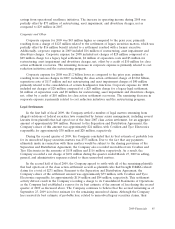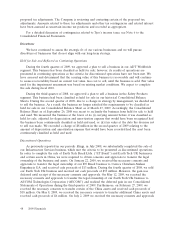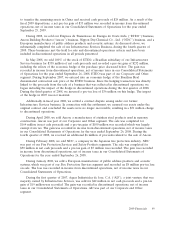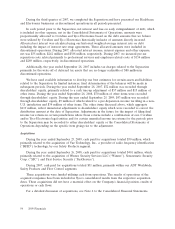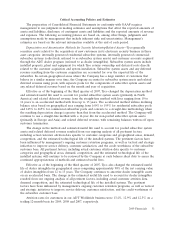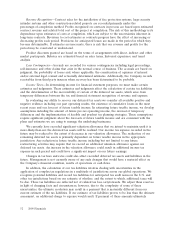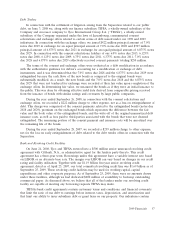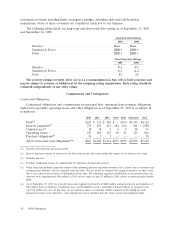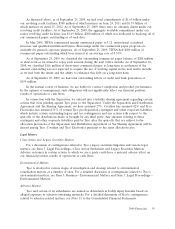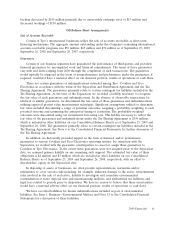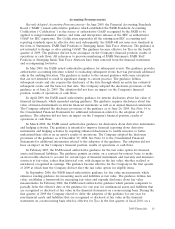ADT 2009 Annual Report Download - page 145
Download and view the complete annual report
Please find page 145 of the 2009 ADT annual report below. You can navigate through the pages in the report by either clicking on the pages listed below, or by using the keyword search tool below to find specific information within the annual report.proves to be less than the recorded amounts, the reversal of the liabilities would result in tax benefits
being recognized in the period when we determine the liabilities are no longer necessary.
Goodwill and Indefinite-Lived Intangible Asset Impairments—Goodwill and indefinite-lived intangible
assets are assessed for impairment annually and more frequently if triggering events occur. In
performing these assessments, management relies on various factors, including operating results,
business plans, economic projections, anticipated future cash flows, comparable transactions and other
market data. There are inherent uncertainties related to these factors which require judgment in
applying them to the analysis of goodwill and indefinite-lived intangible assets for impairment. Since
judgment is involved in performing fair value measurements used in goodwill and indefinite-lived
intangible assets impairment analyses, there is risk that the carrying values of our goodwill or
indefinite-lived intangible assets may be overstated.
We elected to make the first day of the fourth quarter the annual impairment assessment date for
all goodwill and indefinite-lived intangible assets. In the first step of the goodwill impairment test, the
Company compares the fair value of a reporting unit with its carrying amount. Fair value for the
goodwill impairment test is determined utilizing a discounted cash flow analysis based on the
Company’s future budgets discounted using the market participants’ weighted-average cost of capital
and market indicators of terminal year cash flows. Other valuation methods are used to corroborate the
discounted cash flow method. If the carrying amount of a reporting unit exceeds its fair value, goodwill
is considered potentially impaired and further tests are performed to measure the amount of
impairment loss. In the second step of the goodwill impairment test, the Company compares the
implied fair value of reporting unit goodwill with the carrying amount of the reporting unit’s goodwill.
If the carrying amount of a reporting unit’s goodwill exceeds the implied fair value of that goodwill, an
impairment loss is recognized in an amount equal to the excess of the carrying amount of goodwill over
its implied fair value. The implied fair value of goodwill is determined in the same manner that the
amount of goodwill recognized in a business combination is determined. The Company allocates the
fair value of a reporting unit to all of the assets and liabilities of that unit, including intangible assets,
as if the reporting unit had been acquired in a business combination. Any excess of the fair value of a
reporting unit over the amounts assigned to its assets and liabilities represents the implied fair value of
goodwill.
Long-Lived Assets—Assets held and used by the Company, including property, plant and
equipment and amortizable intangible assets, are reviewed for impairment whenever events or changes
in business circumstances indicate that the carrying amount of the asset may not be fully recoverable.
Tyco performs undiscounted operating cash flow analyses to determine if impairment exists. For
purposes of recognition and measurement of an impairment for assets held for use, Tyco groups assets
and liabilities at the lowest level for which cash flows are separately identified. If an impairment is
determined to exist, any related impairment loss is calculated based on fair value. Impairments to
long-lived assets to be disposed of are recorded based upon the fair value less cost to sell of the
applicable assets. The calculation of the fair value of long-lived assets is based on assumptions
concerning the amount and timing of estimated future cash flows and assumed discount rates, reflecting
varying degrees of perceived risk. Since judgment is involved in determining the fair value and useful
lives of long-lived assets, there is a risk that the carrying value of our long-lived assets may be
overstated or understated.
Pension and Postretirement Benefits—Our pension expense and obligations are developed from
actuarial valuations. Two critical assumptions in determining pension expense and obligations are the
discount rate and expected long-term return on plan assets. We evaluate these assumptions at least
annually. Other assumptions reflect demographic factors such as retirement, mortality and turnover and
are evaluated periodically and updated to reflect our actual experience. Actual results may differ from
actuarial assumptions. The discount rate represents the market rate for high-quality fixed income
investments and is used to calculate the present value of the expected future cash flows for benefit
obligations under our pension plans. A decrease in the discount rate increases the present value of
2009 Financials 53




